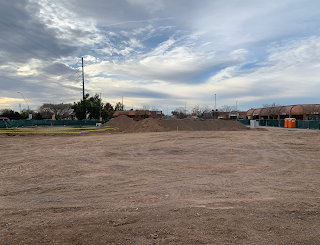Teaching at the Art Institute of Phoenix in 1996
I was one of the first teachers at the Art Institute of Phoenix in 1996. The school, which was on 23rd Avenue and Dunlap, had just been established the year before, and I'd driven past the building many times, and had been curious about it. I stopped in to see what was going on there, and they explained that the school was created to teach different types of computer graphics, like Game Design, Computer Animation, and my specialty, Graphic Design.
The school was based on the idea of giving students a practical education that they could use to go get a job with. And it turns out that I was exactly what they were looking for, a pro in the field, not someone with "book learning". I had been doing graphic design for the past fifteen years, and was current with the technology, and latest software. I had to get a teaching certificate, but ultimately the job was just explaining what I do, and how to do it. I liked that idea, as I had been fortunate enough to be mostly taught by instructors who will still currently working in the field when I got my degree at ASU, not "career teachers" with dusty credentials. I started part-time at the Art Institute of Phoenix, and then they made me an offer I couldn't refuse, and I stayed there until 2001, when I moved over to Glendale Community College.
Their setup was absolute state-of-the-art. When I walked into the computer lab, I knew. I'm no computer expert, but this was my world. The computers were the latest, as was the software. Of course, you have to remember that this was 1996, and the cell phone in your pocket is probably more powerful than computers from that long ago. This was before the use of CDs on computers, and the files were kept on little discs, which were simply a round piece of film encased in plastic. I encouraged my students to do a lot of backups. The discs would fail for no apparent reason, and if a final project was on that failed disc, it was a disaster. I encouraged triple-backups. Even when the use of CDs became common, I still encouraged triple backups. Nowadays, on the computer I'm on right now I have a removable hard drive and built-in software (called Time Machine) which backs up everything every hour on the hour.
A big chunk of what we taught there was professionalism. And that meant getting to class on time, doing the assignments correctly, and the thousands of little things that add up to so much when it's time to go looking for a job. I often had my students do presentations in front of the class as if they were presenting to a client. The students did mock interviews with the teacher of their choice. They dressed for the interview and I tried to stay "in character" as if I were going to hire them, or not. Of course I could step out of character and say, "let's try that again" because, after all, it was a school.
I modeled my teaching style on the teachers I liked the most at ASU when I was a student. I remember the passion that they showed for their art, and I was not afraid to express joy when I saw a student do something really great. I minimized the amount of time I spent talking, and got the students into projects as quickly as possible. I remember that I learned best by doing projects, and the classes I taught were all project-based, not step-by-step or boring tutorials. Tutorials could be gotten out of a book, or nowadays on a YouTube video, and they're worthless.
Whether 1996 qualifies as the "good old days" or not I can't say. From the point of view of computer graphics, it's really ancient history. Technology moves quickly, and being successful means that you're always a student.
Image at the top of this post: A sign that one of my "Superstar" students made for me in 1996, at the Art Institute of Phoenix. No whining.
If you like pictures of old-time Phoenix, please become a member of History Adventuring on Patreon. I share a LOT of cool old photos there, copyright-free, with no advertising. Your support makes it happen! Thank you!




Comments
Post a Comment